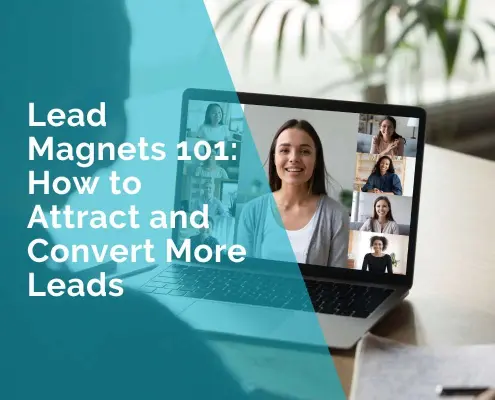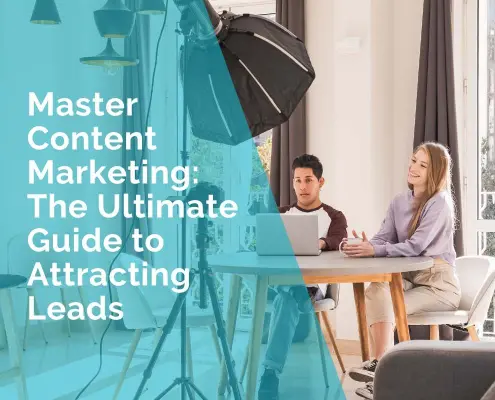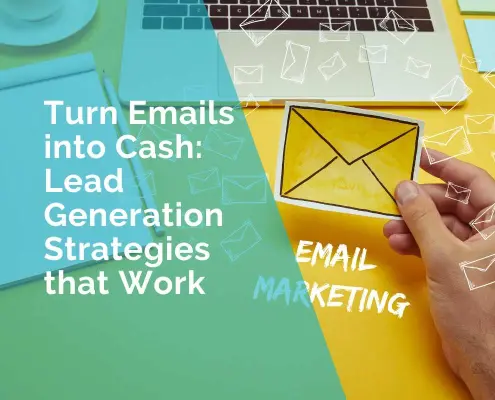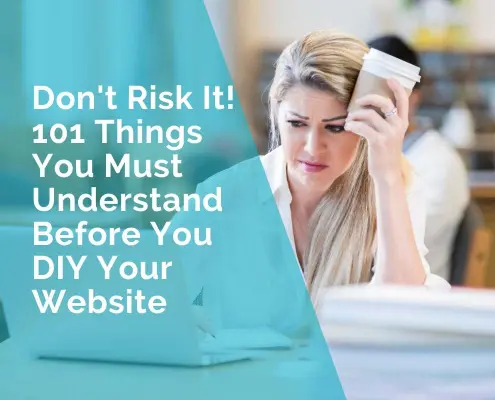Lead Magnets 101: How to Attract and Convert More Leads
Did you know that businesses that use lead magnets see up to 55% more leads? That’s a huge difference that can really boost your growth.
So, what exactly is a lead magnet? It’s something valuable you offer for free to attract potential customers. Think of it as a helpful gift that encourages people to give you their contact information in exchange.
Lead magnets are important because they help you get in touch with people who might be interested in what you offer. They give you a way to connect with potential customers and start building a relationship with them. This is especially useful for small businesses looking to grow.
1. What is a Lead Magnet?
A lead magnet is a free offer that attracts people who might want to buy from you. It’s like a free sample that encourages them to provide their email address or other contact details. This way, you can follow up with them later and hopefully turn them into paying customers.
Types of Lead Magnets:
- E-books: An e-book is a short, informative book that you can download. For example, a fitness coach might offer a free e-book with workout tips and meal plans. It’s a great way to show what you know and attract people interested in fitness.
- Whitepapers: These are detailed reports on a specific topic. A business consultant might create a whitepaper about the latest trends in marketing strategies. It helps show your expertise and attract people who are interested in learning more.
- Checklists: A checklist is a simple list that helps people keep track of tasks. For instance, a home organizer might offer a checklist for decluttering your house. It’s useful and easy for people to use.
- Webinars: Webinars are online seminars where you teach something valuable. A web designer might host a webinar on how to improve your website’s design. It’s a good way to interact with people and showcase your skills.
- Free Trials: A free trial lets people try your service for a limited time without paying. For example, a software company might offer a 30-day free trial of their new app. It helps people experience your product and see its value.
- Templates: Templates are ready-made formats that people can use. A marketing expert might provide free social media post templates. They save time and show how your services can be useful.
- Case Studies: A case study shows how you’ve helped other customers. For instance, a cleaning service might share a case study about a big cleaning job they did. It builds trust and shows how effective you are.
2. The Benefits of Using Lead Magnets
Attracts Quality Leads
Lead magnets help you find the right people who are genuinely interested in your business. For instance, if you run a bakery, offering a free recipe for your best-selling cookies can attract people who love baking. These are the kinds of leads who are likely to visit your bakery or buy your products.
Builds Trust and Authority
By providing useful information for free, you show that you know your stuff. For example, a dentist might offer a free guide on how to keep your teeth healthy. When people see that you offer valuable advice, they start to trust you and see you as an expert in your field.
Increases Conversion Rates
Lead magnets can help turn visitors into customers. Imagine you have an online store selling handmade jewelry. If you offer a free guide on how to choose the perfect piece of crystal jewelry, people who download it are more likely to make a purchase. This guide helps them feel more confident in their buying decision.
Nurtures Relationships
Lead magnets give you a reason to stay in touch with potential customers. After someone downloads your free e-book on gardening tips, you can follow up with more helpful emails about gardening. This keeps your business on their mind and builds a relationship over time.
3. How to Create an Effective Lead Magnet
Identify Your Target Audience
Understand who you’re trying to reach. If you run a fitness studio, your target audience might be people looking to get fit or stay healthy. Knowing their needs helps you create a lead magnet they will find useful.
Choose the Right Format
Pick the type of lead magnet that works best for your audience. If you’re a real estate agent, a free checklist on what to look for in a new home might be perfect. If you run a craft shop, a free DIY project guide could attract more people.
Offer Value
Make sure your lead magnet gives something useful. For example, if you run a photography business, offering a free guide on taking better photos with a smartphone gives people something they can use right away. The more valuable the offer, the more likely people are to give you their contact details.
Craft a Compelling Title
Your title should grab attention and clearly state what people will get. Instead of just calling it “Guide to Gardening,” try “10 Easy Gardening Tips for Beautiful Flowers.” A clear, attractive title helps people understand why they should download it.
Design and Presentation
Your lead magnet should look good and be easy to read. If you’re offering a free meal planner, make sure it’s well-organized and visually appealing. Use simple design tools to create a neat and attractive layout.
Call to Action
Clearly tell people what to do next. After they download your lead magnet, include a simple call to action, like “Sign up for our newsletter for more tips!” or “Book a free consultation now!” This helps guide them on the next steps and keeps the connection going.
4. Strategies for Promoting Your Lead Magnet
Landing Pages:
A landing page is a focused web page designed to drive action. It’s where visitors land after clicking a link to your lead magnet. To make it effective:
- Create a Clear Headline: Your headline should immediately grab attention and let visitors know what they’re getting. For instance, if you’re offering a free e-book on healthy cooking, your headline could be “Get Your Free E-Book: 20 Delicious Recipes for a Healthier You!”
- Explain the Benefits: Clearly outline what the lead magnet offers and how it will help the visitor. For example, if you run a financial planning service, explain how your free guide will help people manage their budgets better and achieve their financial goals.
- Include a Simple Form: Make it easy for visitors to get the lead magnet by having a simple sign-up form. Ask for minimal information, like just an email address. The less information people have to provide, the more likely they are to fill out the form.
- Add a Strong Call to Action: Use a clear, inviting call to action (CTA) button like “Download Now” or “Get My Free Guide.” This button should be easy to spot and encourage visitors to take action.
- Design for Mobile: Ensure your landing page looks good and works well on mobile devices. Many people access websites on their phones, so a mobile-friendly design is crucial.
Email Marketing:
Using your email list to promote your lead magnet is a great way to reach people who are already interested in what you offer:
- Craft an Engaging Email: Write an email that grabs attention. Use a compelling subject line like “Don’t Miss Out: Free Guide to Boost Your Productivity!” In the email body, explain the value of the lead magnet and include a link to access it.
- Personalize Your Message: Address your email recipients by name and tailor the content to their interests. For example, if you’re a pet groomer, mention how your free guide on pet care tips can help them keep their pets looking great.
- Use a Clear CTA: Make sure your email includes a clear CTA that tells recipients what to do next. For example, “Click here to download your free guide now!”
- Follow-Up Emails: Send a follow-up email after they download your lead magnet to thank them and offer additional value. This could include tips related to the lead magnet or special offers on your services.
Social Media:
Social media is a powerful tool to spread the word about your lead magnet:
- Create Eye-Catching Posts: Design posts that are visually appealing and highlight the benefits of your lead magnet. For instance, if you offer a free home organization checklist, share before-and-after photos of a decluttered space with a link to your checklist.
- Use Stories and Reels: On platforms like Instagram and Facebook, use stories and reels to show a behind-the-scenes look or quick tips related to your lead magnet. This can make your offer feel more personal and engaging.
- Engage with Your Audience: Respond to comments and messages about your lead magnet. This interaction can build trust and encourage more people to sign up.
- Run Contests or Giveaways: Host a contest where participants can enter by signing up for your lead magnet. For example, if you’re a photographer, you could offer a free mini-photo session to one lucky person who downloads your photography tips guide.
Paid Advertising:
Paid ads can help you reach people who might not find you otherwise:
- Target the Right Audience: Use ad platforms to target specific groups based on their interests, demographics, and behavior. For example, if you offer a free guide on digital marketing, target small business owners who are looking for marketing tips.
- Design Effective Ads: Create ads that clearly explain what your lead magnet offers and why it’s valuable. Use engaging images or videos and include a strong CTA like “Get Your Free Guide Today!”
- Set a Budget and Monitor Performance: Decide how much you’re willing to spend on ads and track how well they’re performing. Adjust your budget or targeting based on which ads are getting the best results.
- Use Retargeting: Show ads to people who have visited your website but didn’t sign up for your lead magnet. This reminder can help convert visitors into leads.
Partnerships and Collaborations:
Teaming up with other businesses can expand your reach:
- Find the Right Partners: Look for businesses that serve a similar audience but aren’t direct competitors. For example, a wedding planner could partner with a florist to offer a joint lead magnet on wedding planning tips.
- Cross-Promote: Promote each other’s lead magnets to your respective audiences. Share each other’s offers on your websites, social media, and email newsletters.
- Host Joint Events: Collaborate on a webinar or workshop that features both of your expertise. For instance, a personal trainer and a nutritionist might host a joint webinar on fitness and healthy eating.
- Share Resources: Provide mutual support by sharing each other’s lead magnets in your stores or offices. For example, a local bookstore could offer free book summaries from a nearby writing coach.
“When your lead magnet solves a problem, you’re not just attracting leads—you’re building trust“
Ivana Katz
5. Measuring the Success of Your Lead Magnet
Key Metrics:
To see if your lead magnet is working well, you need to track a few important things:
- Downloads: Check how many people are downloading your lead magnet. This tells you if your offer is attractive enough. For example, if you’re offering a free guide on home decorating, count how many times people click to download it.
- Conversion Rates: Look at how many people who visit your landing page end up downloading the lead magnet. If you have 100 visitors and 10 downloads, your conversion rate is 10%. This helps you understand if your landing page is effective.
- Engagement Levels: See how people interact with your lead magnet after they get it. For instance, if you’re offering a free meal planner, check if people are using it and if they’re following any related advice or tips you’ve shared. This shows if your lead magnet is genuinely useful.
A/B Testing:
A/B testing is about trying different versions of your lead magnet to see which one works better:
- Create Two Versions: Make two different versions of your lead magnet. For example, you might offer two different styles of free templates for social media posts.
- Test Them: Show each version to different groups of people. Track which version gets more downloads or better feedback.
- Analyze Results: Compare the results to see which version was more effective. This helps you understand what your audience prefers and can lead to better results in the future.
Feedback and Adjustments:
Getting feedback and making changes can improve your lead magnet:
- Ask for Feedback: After people download your lead magnet, ask them what they think. You can do this through surveys or follow-up emails. For example, if you offer a free guide on DIY repairs, ask users if it helped them with their projects.
- Make Improvements: Use the feedback to make changes. If people say your guide is missing some details, update it to include that information.
- Regular Updates: Periodically review and update your lead magnet to keep it relevant and useful. For instance, if you’re offering a seasonal guide, make sure to update it with new tips or information each year.
6. Common Mistakes to Avoid
Offering Too Much or Too Little
Make sure your lead magnet provides enough value but isn’t overwhelming. If you offer a free e-book, keep it focused and concise. Offering a massive guide can be intimidating, while something too basic may not be helpful.
Ignoring Your Audience’s Needs
Ensure your lead magnet is relevant to what your target audience wants. For example, if your business is a pet grooming service, don’t offer a lead magnet on car maintenance. Focus on topics related to pet care.
Overcomplicating the Sign-Up Process
Keep the sign-up process simple. If people have to fill out a long form to get your lead magnet, they might give up. Ask for just an email address or basic info.
Neglecting Follow-Up
Don’t forget to follow up with people after they get your lead magnet. Send a thank-you email and provide additional helpful content. This keeps the relationship going and encourages further engagement.
Not Testing Your Lead Magnet
Before you launch, test your lead magnet to make sure it works well. Check for any errors or issues and make sure it looks good and functions properly.
Lead magnets are a great way to attract and engage potential customers. To make the most of them, keep your offer simple and easy to use, ensure it’s relevant to what your audience wants, and don’t forget to follow up with additional support. By avoiding common mistakes and focusing on these key points, you can effectively use lead magnets to grow your business and build lasting relationships with your customers.
Resources and Tools
Tools for Creating Lead Magnets
- Canva: Design tool with templates for creating e-books, checklists, and more.
- Google Docs: Simple document editor for formatting e-books and guides.
- Adobe Acrobat: Software for creating and editing PDF documents.
- Leadpages: Tool for building custom landing pages to promote lead magnets.
- Mailchimp: Email marketing platform for managing campaigns and promotions.
- HubSpot: Comprehensive tool for creating lead magnets, landing pages, and email marketing.
Tools for Promoting Lead Magnets
- Buffer: Social media management tool for scheduling and managing posts.
- Hootsuite: Another tool for managing and scheduling social media posts.
- Facebook Ads: Platform for creating targeted ads on Facebook.
- Google Ads: Service for creating search and display ads to attract visitors.
- Instagram Ads: Advertising tool for running ads on Instagram.
Tools for Measuring Success
- Google Analytics: Tracks and analyzes website traffic and user behavior.
- Hotjar: Provides heatmaps and recordings to see how users interact with your site.
- Klipfolio: Dashboard tool for tracking key performance metrics.
- Crazy Egg: Offers heatmaps and user tracking for website analysis.
- Optimizely: A/B testing tool to experiment with different versions of your lead magnet.
- VWO (Visual Website Optimizer): Tool for testing and optimizing website elements.
Resources for Learning and Inspiration
- Neil Patel Blog: Offers tips and strategies on digital marketing and lead generation.
- HubSpot Academy: Free courses and tutorials on marketing and lead generation.
- Content Marketing Institute: Provides articles and insights on content marketing.
- Copyblogger: Offers advice on creating compelling content and lead magnets.
Frequently Asked Questions
What is a lead magnet?
A lead magnet is a valuable offer given to potential customers in exchange for their contact information, usually an email address. It’s designed to attract and engage your target audience by offering something they find useful. Examples include free e-books, checklists, webinars, or trials. The goal is to capture leads who are interested in your business so you can nurture them into customers.
Why are lead magnets important for lead generation?
Lead magnets are crucial because they provide a way to attract potential customers and gather their contact details. They help build your email list, establish trust with your audience, and offer a taste of what you can provide. By offering valuable content or resources, you increase the likelihood of converting leads into paying customers.
How do I choose the right lead magnet for my business?
To choose the right lead magnet, consider your audience’s needs and pain points. Think about what information or resource would be most helpful to them. For example, if you’re a fitness coach, a free workout plan or nutrition guide might be appealing. The lead magnet should align with your business goals and address a specific problem your audience faces.
What are some common types of lead magnets?
Common types of lead magnets include:
- E-books: Comprehensive guides on a particular topic.
- Checklists: Simple lists that help users accomplish tasks or stay organized.
- Whitepapers: In-depth reports or studies on industry-specific issues.
- Webinars: Live or recorded presentations offering valuable insights.
- Free Trials: Limited access to your service or product to let users experience it.
- Templates: Ready-to-use documents or tools that simplify a process.
- Case Studies: Detailed analyses of how your product or service helped a client
How can I create an effective lead magnet?
To create an effective lead magnet:
- Identify Your Audience: Understand what your potential customers need and want.
- Choose a Format: Select a format that suits your audience and the type of content you’re offering.
- Offer Value: Make sure the lead magnet provides real value and solves a specific problem.
- Design Well: Ensure it’s visually appealing and easy to use.
- Promote It: Use your website, social media, and email marketing to get the word out.
How do I promote my lead magnet?
Promote your lead magnet by:
- Creating a Landing Page: Design a dedicated page where visitors can easily download or sign up for the lead magnet.
- Using Social Media: Share posts and ads on platforms like Facebook, Instagram, and LinkedIn to drive traffic.
- Running Paid Ads: Use Google Ads or social media ads to target specific audiences.
- Email Marketing: Send out emails to your existing list encouraging them to check out the lead magnet.
- Partnerships: Collaborate with other businesses or influencers to extend your reach.
What should I include on the landing page for my lead magnet?
Your landing page should include:
- A Clear Headline: Make it obvious what the lead magnet offers.
- A Brief Description: Explain what the lead magnet includes and how it benefits the user.
- A Simple Sign-Up Form: Collect minimal information, usually just an email address.
- A Strong Call to Action: Use a clear and inviting button, like “Download Now” or “Get Your Free Guide.”
- Visuals: Include images or graphics to make the page more engaging.
How often should I update my lead magnets?
Update your lead magnets regularly to keep them relevant and valuable. If your lead magnet is a guide or report, review it every 6-12 months to ensure the information is current. For seasonal content or topics that change frequently, like industry trends, more frequent updates may be necessary.
Can lead magnets be used for all types of businesses?
Yes, lead magnets can be used for nearly all types of businesses. The key is to tailor the lead magnet to your industry and target audience. For example:
- Retail: Offer discount codes or exclusive shopping guides.
- Consulting: Provide free consultations or how-to guides.
- Tech: Offer software trials or tech solution whitepapers.
How do I measure the success of my lead magnet?
Measure the success of your lead magnet by tracking:
- Downloads or Sign-Ups: How many people are accessing your lead magnet?
- Conversion Rates: The percentage of visitors who sign up compared to those who see the landing page.
- Engagement: How users interact with the lead magnet, such as whether they use the resources or follow up with additional content.
- Feedback: Collect user feedback to see how well the lead magnet is received.
What’s the best format for a lead magnet?
The best format depends on your audience and the type of content you’re offering. Popular formats include:
- E-books: For in-depth information.
- Checklists: For quick and actionable tasks.
- Webinars: For interactive learning and engagement.
- Templates: For ready-to-use resources. Choose a format that aligns with your audience’s preferences and the nature of your offer.
 Ivana Katz from Websites 4 Small Business is an award winning web designer who builds websites that build your business. She provides unbeatable web design services to fit your budget.
Ivana Katz from Websites 4 Small Business is an award winning web designer who builds websites that build your business. She provides unbeatable web design services to fit your budget.
The end result? Professional, custom-made sites that give your business the extra oomph it needs to stand out from the competition and make an impact.
Whether you’re a brand-new business or an established one ready to improve your digital presence, Ivana makes it easy to get your business online very quickly. Her websites are professional, tailored to fit your budget, and give your business a serious boost.
Download your FREE copy of “Ultimate Website Design Secrets Blackbook – 10 Bulletproof Strategies for Designing an Outrageously Successful Website”












